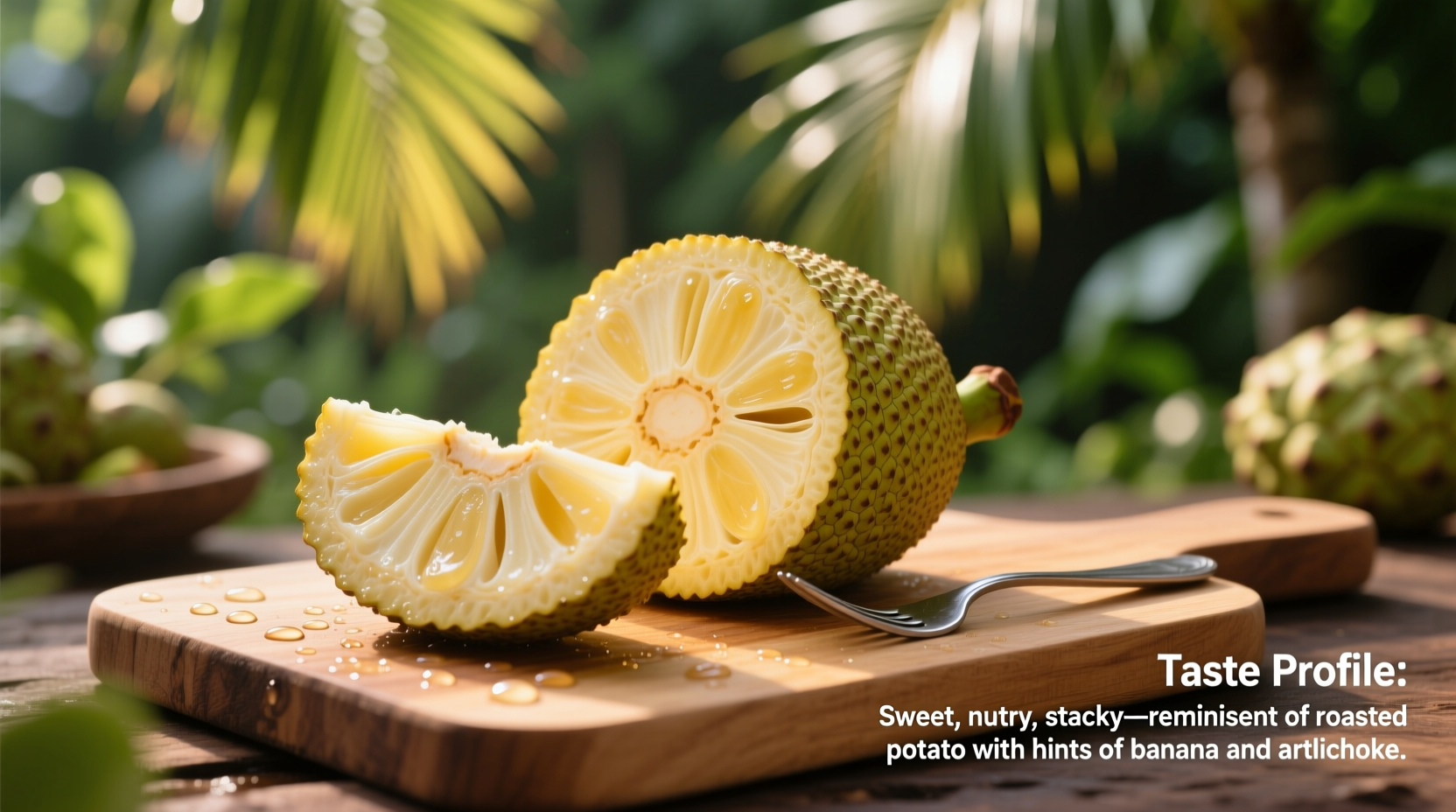Understanding Breadfruit's Flavor Journey
When exploring what does breadfruit taste like, you're actually asking about a fruit with multiple distinct flavor profiles. Breadfruit transforms dramatically from unripe to ripe stages, creating entirely different culinary experiences. This tropical staple, scientifically known as Artocarpus altilis, offers versatile taste possibilities that have sustained Pacific Island communities for centuries.
How Ripeness Transforms Breadfruit's Taste
The single most important factor determining what does breadfruit taste like is its ripeness. This transformation follows a clear progression:
- Unripe (firm, green skin): Starchy, neutral flavor similar to raw potato or yuca with subtle artichoke heart notes. Ideal for savory preparations.
- Semi-ripe (yellowing skin, slightly soft): Mild sweetness emerges with nutty undertones. Texture becomes creamy when cooked.
- Fully ripe (yellow to brown skin, soft): Distinct tropical sweetness reminiscent of banana, mango, and pineapple with custard-like texture.
According to agricultural researchers at the University of Hawaii's College of Tropical Agriculture and Human Resources, this transformation occurs as starches convert to sugars during ripening—a process similar to bananas but with unique flavor compounds specific to breadfruit (ctahr.hawaii.edu).
Texture's Role in Flavor Perception
When considering what does breadfruit taste like, texture significantly influences your experience:
- Raw unripe breadfruit: Crunchy with dense, starchy flesh (not typically eaten raw)
- Cooked unripe breadfruit: Tender yet firm, similar to cooked potato or artichoke heart
- Ripe breadfruit: Soft, creamy texture comparable to ripe banana or mango
Caribbean culinary experts note that improper cooking of unripe breadfruit can leave an unpleasant, chalky mouthfeel that masks its subtle flavors—a common reason first-time tasters report disappointment (Food and Agriculture Organization of the United Nations).
Breadfruit Flavor Comparisons
| Ripeness Stage | Flavor Profile | Best Preparation Method |
|---|---|---|
| Unripe (green) | Starchy, neutral, mild artichoke/potato notes | Boiled, roasted, or fried for savory dishes |
| Semi-ripe (yellowing) | Nutty, mild sweetness, subtle tropical hints | Grilled, baked, or added to stews |
| Ripe (yellow/brown) | Sweet tropical (banana/mango/pineapple), custardy | Eaten raw, baked into desserts, or made into smoothies |
Factors That Influence Breadfruit's Taste Experience
Several elements affect what does breadfruit taste like when you try it:
Varietal Differences
With over 200 known varieties, breadfruit flavors vary significantly. The seeded 'Ma'afala' variety common in Samoa has a stronger flavor than the seedless 'Drupe' variety popular in Jamaica. Pacific Island agricultural resources document how traditional cultivars were specifically selected for preferred taste characteristics over generations (Pacific Crops Research Network).
Cooking Methods
How you prepare breadfruit dramatically changes its flavor profile:
- Boiling unripe breadfruit: Creates a clean, neutral base perfect for absorbing other flavors
- Roasting or grilling: Develops nutty, caramelized notes through Maillard reaction
- Frying: Adds richness while maintaining starchy texture
- Baking ripe breadfruit: Concentrates sweetness and enhances tropical notes

Common Misconceptions About Breadfruit Taste
Many first-time tasters have unrealistic expectations about what does breadfruit taste like:
- "It should taste like bread" - The name refers to its starchy texture when cooked, not actual bread flavor
- "All breadfruit tastes the same" - Ripeness stage creates completely different eating experiences
- "Ripe breadfruit is always sweet" - Some varieties maintain more neutral flavors even when ripe
Field research by agricultural anthropologists shows these misconceptions often stem from trying improperly prepared breadfruit or expecting a single consistent flavor profile (Journal of Ethnobiology).
Practical Guidance for First-Time Breadfruit Tasters
Understanding what does breadfruit taste like helps you select and prepare it properly:
For Savory Lovers
Select firm, unripe breadfruit with completely green skin. Boil until tender (about 20-30 minutes), then try it with salt and pepper or incorporate into stews. The mild flavor readily absorbs seasonings—Caribbean chefs often compare it to potato but with more interesting texture.
For Sweet Tooth Preferences
Wait until breadfruit develops yellow spots and yields slightly to pressure. Bake or grill to enhance natural sweetness. Ripe breadfruit shines in desserts where its tropical notes complement coconut, vanilla, and cinnamon.
Troubleshooting Common Issues
If your breadfruit tastes bitter or unpleasant:
- You may have selected overripe or spoiled fruit (avoid brown, mushy specimens)
- Unripe breadfruit requires thorough cooking to eliminate latex sap
- Some varieties naturally have stronger flavors that may not appeal to all palates
Why Breadfruit's Taste Matters Culturally
Breadfruit's flavor versatility explains its historical importance across the Pacific Islands and Caribbean. Unlike many staple crops, it provides both savory and sweet eating experiences depending on ripeness—making it exceptionally valuable for food security. Traditional preparation methods developed over centuries optimize its flavor potential at each stage, transforming what might seem like a bland starch into diverse culinary experiences.











 浙公网安备
33010002000092号
浙公网安备
33010002000092号 浙B2-20120091-4
浙B2-20120091-4